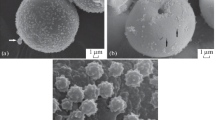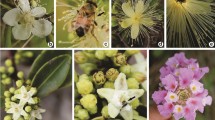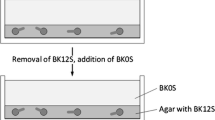Abstract
The aim of this research was to study the composition of pollen tubes of Scots pine (Pinus sylvestris L.). Pollen cultivation on deionized distilled water excluded the potential influence of the cultivation medium on the pollen tube growth and development. The fluorescent study indicated a gradual distribution of chemical compounds along the length of the tube. It was shown that the protoplast apical zone and the parietal layer near the tube’s tip are most likely actively involved in the ion transport regulation in the growing pollen tube. The callose synthesis in the tip of matured pine tube completed the first stage of its active growth. Significant differences and pH gradients at the nucleus region and the parietal layer of the tube wall indicate that H+ gradient is the direct driving force of vesicle transport and can regulate the growth of pollen tubes. The distribution of amino acids, RNA, proteins and lipids was uniform throughout the length of the pine pollen tube. The content of amino acids, RNA, DNA and proteins slightly increased near the cell nucleus and drastically increased in the apical zone. At the very tip of the tube, a slight increase in the concentration of polysaccharides and a significant decrease in the content of amino acids, RNA, DNA, proteins and lipids were detected.





Similar content being viewed by others
Data availability
Data sharing does not apply to this article as no datasets were generated or analyzed in the study.
Abbreviations
- DAPI:
-
4′,6–Diamidino-2-phenylindole
- DTIR:
-
Disturbed total internal reflection
- Fluorescein-DHPE:
-
N-(Fluorescein-5-thiocarbamoyl)-1,2-dihexadecanoyl-sn-glycero-3-phosphoethanolamine, triethylammonium salt
- FTIR:
-
Fourier-transform infrared spectroscopy
- IR spectra:
-
Infrared spectra
- MQAE:
-
N-(Ethoxycarbonylmethyl)-6-methoxyquinolinium bromide
References
Breygina MA, Matveyeva NP, Andreyuk DS, Yermakov IP (2012) Transmembrane transport of K+ and Cl– during pollen grain activation in vivo and in vitro. Russ J Dev Biol 43(2):85–93. https://doi.org/10.1134/S1062360412020038
Breygina M, Klimenko E, Schekaleva O (2021) Pollen germination and pollen tube growth in Gymnosperms. Plants 10(7):1301. https://doi.org/10.3390/plants10071301
Cao Y, Hao RZ, Liu MQ, An XM, Jing YP (2012) Distribution of nuclei and microfilaments during pollen germination in Populus tomentosa Carr. Afr J Agric Res 7(17):2679–2682. https://doi.org/10.5897/AJAR11.1734
da Costa ML, Pereira LG, Coimbra S (2013) Growth media induces variation in cell wall associated gene expression in Arabidopsis thaliana pollen tube. Plants 2(3):429–440. https://doi.org/10.3390/plants2030429
Derksen J, Li YQ, Knuiman B, Geurts H (1999) The wall of Pinus sylvestris L. pollen tubes. Protoplasma 208:26–36. https://doi.org/10.1007/BF01279072
Domozych DS, Fujimoto C, LaRue T (2013) Polar expansion dynamics in the plant kingdom: a diverse and multifunctional journey on the path to pollen tubes (Review). Plants 2(1):148173. https://doi.org/10.3390/plants2010148
EMU notes in mineralogy 6: Spectroscopic Methods in Mineralogy (2004) Beran A and Libowitzky E (ed.), p 662
Feijó JA, Sainhas J, Hackett GR, Kunkel JG, Hepler PK (1999) Growing pollen tubes possess a constitutive alkaline band in the clear zone and a growth-dependent acidic tip. J Cell Biol 144(3):483–496. https://doi.org/10.1083/jcb.144.3.483
Fernando DD, Lazzaro MD, Owens JN (2005) Growth and development of conifer pollen tubes. Sex Plant Reprod 18(4):149–162. https://doi.org/10.1007/s00497-005-0008-y
Fricker MD, White NS, Obermeyer G (1997) pH gradients are not associated with tip growth in pollen tubes of Lilium longiflorum. J Cell Sci 110(15):1729–1740. https://doi.org/10.1242/jcs.110.15.1729
Hepler PK, Kunkel JG, Rounds CM, Winship LJ (2012) Calcium entry into pollen tubes. Trends Plant Sci 17:32–38. https://doi.org/10.1016/j.tplants.2011.10.007
Hepler PK, Lovy-Wheeler A, McKenna ST, Kunkel JG (2006) Ions and pollen tube growth. In: Malhó R (ed) The pollen tube. Plant cell monographs. Springer-Verlag, Berlin, pp 47–69
Higashiyama T, Inatsugi R (2006) Comparative analysis of biological models used in the study of pollen tube growth. In: Malhó R (ed) The pollen tube. Plant cell monographs. Springer-Verlag, Berlin, pp 265–286
Jensen WA (1962) Botanical histochemistry, Principles and practice. W H Freeman & Co., San Francisco
Kozubov GM, Trenin VV, Tikhova MA, Kondrat´eva VP (1982) Reproductive structures of gymnosperms. (comparative description). Science, Leningrad, 104 p.
Krichevsky A, Kozlovsky SV, Tian GW, Chen MH, Zaltsman A, Citovsky V (2007) How pollen tubes grow (Review). Dev Biol 303(2):405–420. https://doi.org/10.1016/j.ydbio.2006.12.003
Lahlali R, Jiang Y, Kumar S, Karunakaran C, Liu X, Borondics F, Hallin E, Bueckert R (2014) ATR–FTIR spectroscopy reveals involvement of lipids and proteins of intact pea pollen grains to heat stress tolerance. Front Plant Sci 5:747. https://doi.org/10.3389/fpls.2014.00747
Liu J, Piette BMAG, Deeks MJ, Franklin-Tong VE, Hussey PJ (2010) A compartmental model analysis of integrative and self- regulatory ion dynamics in pollen tube growth. PLoS One. https://doi.org/10.1371/journal.pone.0013157
Malhó R, Serrazina S, Saavedra L, Dias FV, Ul-Rehman R (2015) Ion and lipid signaling in apical growth—a dynamic machinery responding to extracellular cues. Front Plant Sci. https://doi.org/10.3389/fpls.2015.00816
Matveeva NP, Andreyuk DS, Voitsekh OO, Ermakov IP (2003) Regulatory changes in the intracellular pH and Cl– efflux at early stages of pollen grain germination in vitro. Russ J Plant Physiol 50:318–323. https://doi.org/10.1023/A:1023814002263
Messerli AM, Robinson KR (2003) Ionic and osmotic disruptions of the lily pollen tube oscillator: testing proposed models. Planta 217(1):147–157. https://doi.org/10.1007/s00425-003-0972-0
Messerli MA, Smith PJS, Lewis RC, Robinson KR (2004) Chloride fluxes in lily pollen tubes: a critical reevaluation. Plant J 40(5):799–812. https://doi.org/10.1111/j.1365-313X.2004.02252.x
Michard E, Simon AA, Tavares BB, Wudick MM, Feijó JA (2017) Signaling with ions: the keystone for apical cell growth and morphogenesis in pollen tubes. Plant Physiol 173:91–111. https://doi.org/10.1104/pp.16.01561
Mollet JC, Leroux C, Dardelle F, Lehner A (2013) Cell wall composition, biosynthesis and remodeling during pollen tube growth. Plants 2(1):107–147. https://doi.org/10.3390/plants2010107
Onelli E, Moscatelli A (2013) Endocytic pathways and recycling in growing pollen tubes (Review). Plants 2:211–229. https://doi.org/10.3390/plants2020211
Pausheva ZP (1988) Workshop on plant cytology. Agropromizdat, Moscow
Pierson ES, Smith PJS, Shipley AM, Jaffe LF, Cresti M, Hepler PK (1993) Ca2+ fluxes around pollen grains and pollen tubes of lily; normal development and effects of thermal shock, BAPTA-type buffer microinjection and depletion of boric acid from the medium. Biol Bull 185(2):302–303. https://doi.org/10.1086/BBLv185n2p302
Schuldiner S, Fishkes H, Kanner BI (1978) Role of a transmembrane pH gradient in epinephrine transport by chromaffin granule membrane vesicles. Proc Natl Acad Sci U S A. 75(8):3713–3716. https://doi.org/10.1073/pnas.75.8.3713
Surso MV, Chuhchin DG, Khviyuzov SS, Pokryishkin SA (2020) Mechanism of pollen germination and pollen tubes’ growth in common juniper (Juniperus communis L.) in vitro. Russ J Dev Biol 51(5):294–303. https://doi.org/10.1134/S1062360420050070
Tavares B, Moura TF, Dias PN, Feijo A, Domingos P, Moura TF, Feijó JA, Bicho A (2011) Calcium-regulated anion channels in the plasma membrane of Lilium longiflorum pollen protoplasts. New Phytol 192:45–60. https://doi.org/10.1111/j.1469-8137.2011.03780.x
Taylor P, Hepler PK (1997) Pollen germination and tube growth. Annu Rev Plant Physiol Plant Mol Biol 48:461–491. https://doi.org/10.1146/annurev.arplant.48.1.461
Vartanian E, Barres O, Roque C (2015) FTIR spectroscopy of woods: a new approach to study the weathering of the carving face of a sculpture. Spectrochim Acta Part A Mol Biomol Spectrosc 136:1255–1259. https://doi.org/10.1016/j.saa.2014.10.011
Watanabe R, Soga N, Yamanaka T, Noji H (2014) High-throughput formation of lipid bilayer membrane arrays with an asymmetric lipid composition. Sci Rep 4:7076. https://doi.org/10.1038/srep07076
Winship LJ, Rounds C, Hepler PK (2017) Perturbation analysis of calcium, alkalinity and secretion during growth of lily pollen tubes. Plants 6(1):3. https://doi.org/10.3390/plants6010003
Yatomi R, Nakamura S, Nakamura N (2002) Immunochemical and cytochemical detection of wall components of germinated pollen of Gymnosperms. Grana 41(1):21–28. https://doi.org/10.1080/00173130260045468
Zimmermann B (2018) Chemical characterization and identification of Pinaceae pollen by infrared microspectroscopy. Planta 247:171–180. https://doi.org/10.1007/s00425-017-2774-9
Zonia L, Cordeiro S, Tupy J, Feijó JA (2002) Oscillatory chloride efflux at the pollen tube apex has a role in growth and cell volume regulation and is targeted by inositol 3,4,5,6- tetrakisphosphate. Plant Cell 14(9):2233–2249. https://doi.org/10.1105/tpc.003830
Acknowledgements
The research was carried out using the equipment of the Center for Collective Use "Arctic" of the Northern (Arctic) Federal University named after M.V. Lomonosov.
Funding
The work was carried out within the framework of the state assignment to the Federal Research Center for the Integrated Study of the Arctic of the Ural Branch of the Russian Academy of Sciences (state registration no. 122011400384-2).
Author information
Authors and Affiliations
Contributions
All authors have made an equal contribution to the preparation of materials and the writing of this article.
Corresponding author
Ethics declarations
Conflict of interest
The authors declare that they have no competing interests.
Human and animal rights
This article does not contain any studies involving humans and animals as research objects.
Additional information
Publisher's Note
Springer Nature remains neutral with regard to jurisdictional claims in published maps and institutional affiliations.
Rights and permissions
Springer Nature or its licensor (e.g. a society or other partner) holds exclusive rights to this article under a publishing agreement with the author(s) or other rightsholder(s); author self-archiving of the accepted manuscript version of this article is solely governed by the terms of such publishing agreement and applicable law.
About this article
Cite this article
Surso, M., Khviyuzov, S. & Chukhchin, D. Compounds composition of pollen tubes of Scots pine (Pinus sylvestris L.). Physiol Mol Biol Plants 29, 1261–1268 (2023). https://doi.org/10.1007/s12298-023-01353-1
Received:
Revised:
Accepted:
Published:
Issue Date:
DOI: https://doi.org/10.1007/s12298-023-01353-1




